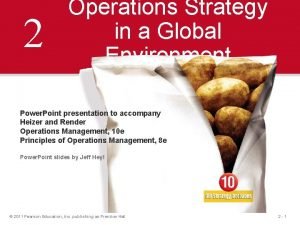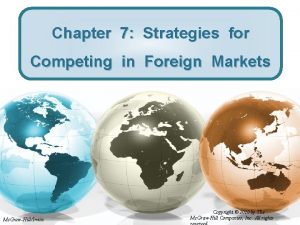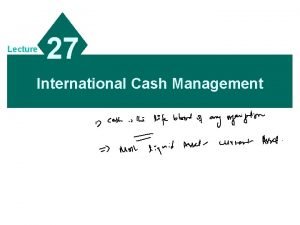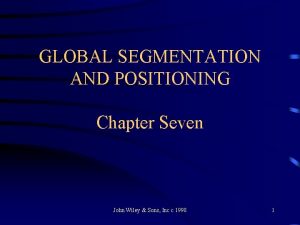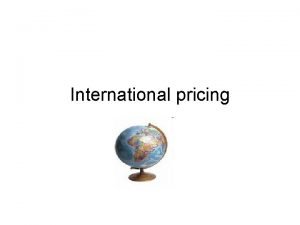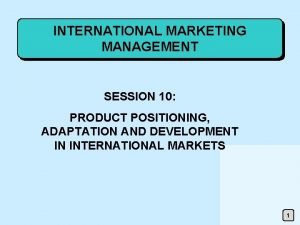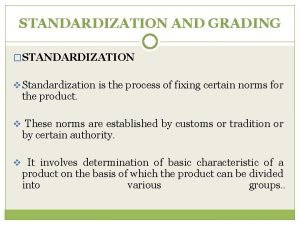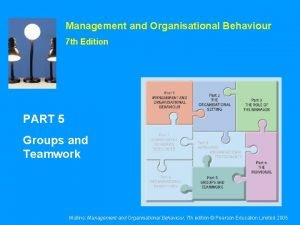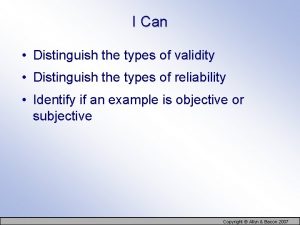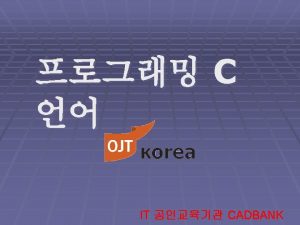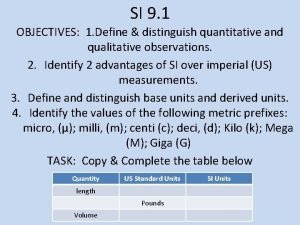n Define the International Strategies n Distinguish the


























- Slides: 26


大綱 n Define the International Strategies n Distinguish the Possible Motivations for FDI and MNC n Describe the Diamond Model n International Corporate level Strategy n Discussions

Definition of International Strategy n. A strategy through which the firm sells its goods or services outside its domestic market – 如何執行活動?是否涉及生產行為? • 找國外代理商、授權製造、特許加盟、設分公司( 獨資或是合資) – International markets yield potential new opportunities – A possible way for extending a product’s life cycle – A opportunity for developing the globally branded product

International Opportunities(1) n Increased Market Size – Extending the Product life cycle – Access the large potential market – Lower the risk for R&D investment – Lower the risk for Marketing investment – Similar demand derived from industrialization – 規模愈大,除了可降低成本的意涵外,還代 表可執行差異化的能耐與資源 • Whirlpool in India • The Importance of China Market • Example of Coca-Cola and Pepsi

International Opportunities (2) n Return on Investment – Large market is crucial for earning a return on investment ( R&D intensive industries or Marketing intensive industries) – Increasing the development pace for new technology (Auto industry) – Recoup the new-product development cost by internationalization (Computer Hardware) – Generate the above-average returns on investment (Mc. Donald, KFC)

International Opportunities (3) n Economies of Scale and Learning – Technology Driving forces for lower cost – Product standardization & Similar product facilities – Large size is positively related with slack resource – Exploit the core competencies through resource and knowledge sharing – Pursuit synergy – Provide new learning opportunity

International Opportunities (4) n Advantage in Location – Lower the basic costs of the goods or service they provide – Access to lower-cost labor, energy or other natural resources – Access to critical suppliers and customers – 地點優勢不只是來自於具有低成本的勞 或 生產,還可能因為靠近市場、具有整合資源 效益、具有附加價值… • Example of Hong Kong, Hungary, New York… • 台灣電子廠商的海外佈局 • 在台外商






進入模式的選擇(Entry Mode) n 出口(Exporting) – 化妝品 n 授權(Licensing) – 軟性飲料製造業、日用品業 n 特許權(Franchising) – Mc. Donald、KFC(混合直接投資) n 合資(Joint Venture) – 新光三越、SOGO、星巴客 n 直接投資(Wholly Owned Subsidiary) – 自己設立,或是購併 – Honda in Taiwan, British American Tobacco in Korea, Channel, LV…等精品


International Business Level Strategy: Diamond Model n Factor of Production – Necessary inputs to compete in any industry n Demand Conditions – Nature and size of a market segment in the home market n Related and Supporting Industries – Contributors to the success of an industry n Firm Strategy, Structure, and Rivalry

Determinants of National Advantage Factors of Production Firm Strategy, Structure, and Rivalry Demand Conditions Related and Supporting Industries

Implications for Diamond Model n Importance for Home Country Market – The home country of operation is often the most important source of competitive advantage n Forming a Competitive Population n Government Role – Challengers, Catalyst

International Corporate Level Strategy High Need For Global Integration Global Strategy Transnational Strategy Multi-domestic Strategy Need for Local Responsiveness High

International Corporate Level Strategy (1) n Multi-domestic strategy(多地區策略) – Higher degree of local responsiveness and Lower degree of global integration – Strategic and operating decisions are decentralized to the business unit in each country – Pursuit Customization in each country – Increasing the potential local market share – Increasing the operating uncertainty – 顧問業、MTV台、速食連鎖業

International Corporate Level Strategy (2) n Global Strategy(全球策略) – Lower degree of local responsiveness and Higher degree of global integration – Offer standardized products across countries – Emphasize economies of scale – Offer greater opportunities to utilize innovations – Forgo growth opportunities in local – 電腦硬體業、化妝品業、精品業、高價手錶

International Corporate Level Strategy (3) n Transnational Strategy(跨國策略) – Higher degree of local responsiveness and Higher degree of global integration – Achieve both global efficiency and local responsiveness – Flexible coordination – Possible conflicting goals in each country • 日用品(P&G、Unilever(由多地區策略轉為跨國 策略)) • 汽車業(GM, Chrysler, Toyota…) • 電信業、航空業、低價手錶



Discussions n 如何由價值鏈活動, 思考全球佈局 – 配置性、協調性 n 世界經濟板塊的區分 n Liability of Foreignness – Focus less on truly global markets, and more on regional adaptation – Importance of local adaptation n Regionalization – Location choice for implementing – Choose similar location or not

Discussions: Semi-Globalization( 準全球化) n The regional economic integration is a trend n The MNC’s global expansion varies according to its distance framework – Cultural distance – Administrative distance – Geographic distance – Economic distance – Distance does matter, and it is possible the explanation for regional economic integration

 Define distinguish
Define distinguish Global product strategies
Global product strategies Direct investment and collaborative strategies
Direct investment and collaborative strategies International business policy and strategy
International business policy and strategy International operations strategy
International operations strategy Strategies for competing in international markets
Strategies for competing in international markets Objective of international cash management
Objective of international cash management Global segmentation and positioning
Global segmentation and positioning International pricing strategies
International pricing strategies Product positioning in international market
Product positioning in international market Domestic market extension orientation
Domestic market extension orientation Reading strategy
Reading strategy Group and team difference
Group and team difference Contribution vs profit
Contribution vs profit Fairest of mortals thou distinguish'd care
Fairest of mortals thou distinguish'd care Puberty reproductive system
Puberty reproductive system Difference between grading and standardization
Difference between grading and standardization Irrotational flow means *
Irrotational flow means * Distinguish between motivation and satisfaction
Distinguish between motivation and satisfaction Distinguish between group and team.
Distinguish between group and team. Atomic
Atomic Similarities between health education and health promotion
Similarities between health education and health promotion Good afternoon to you all
Good afternoon to you all What is octane number
What is octane number Vasa recta vs peritubular capillaries
Vasa recta vs peritubular capillaries Jeff bezos accident
Jeff bezos accident Pour point of diesel
Pour point of diesel




